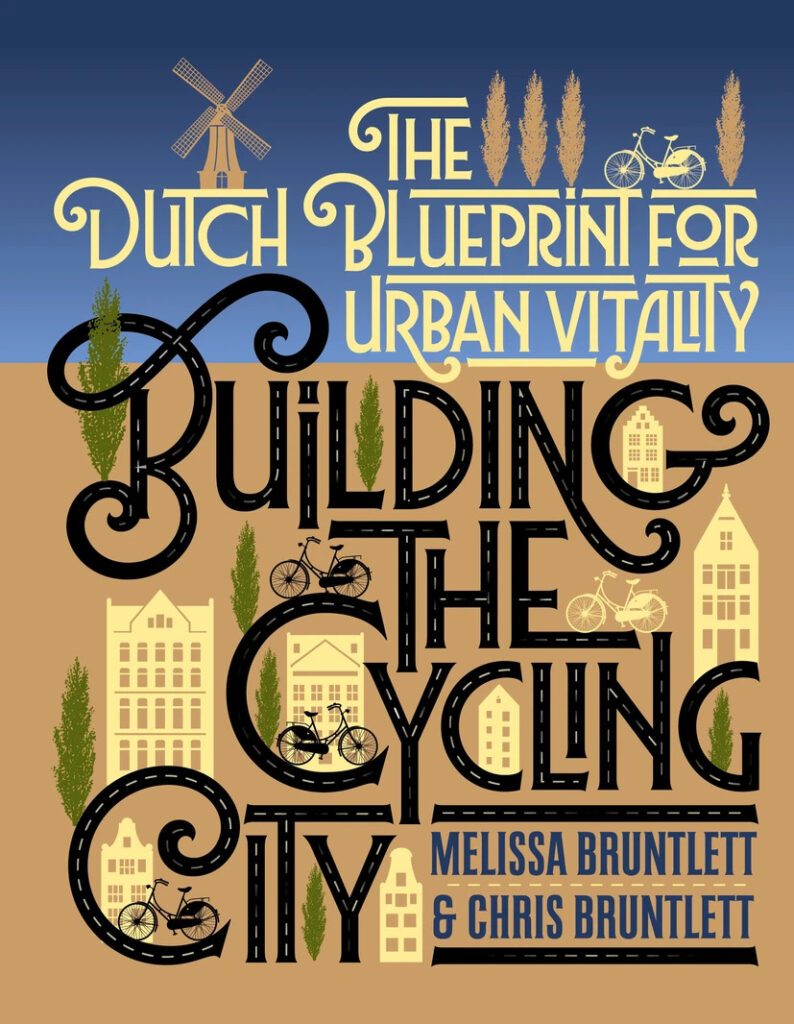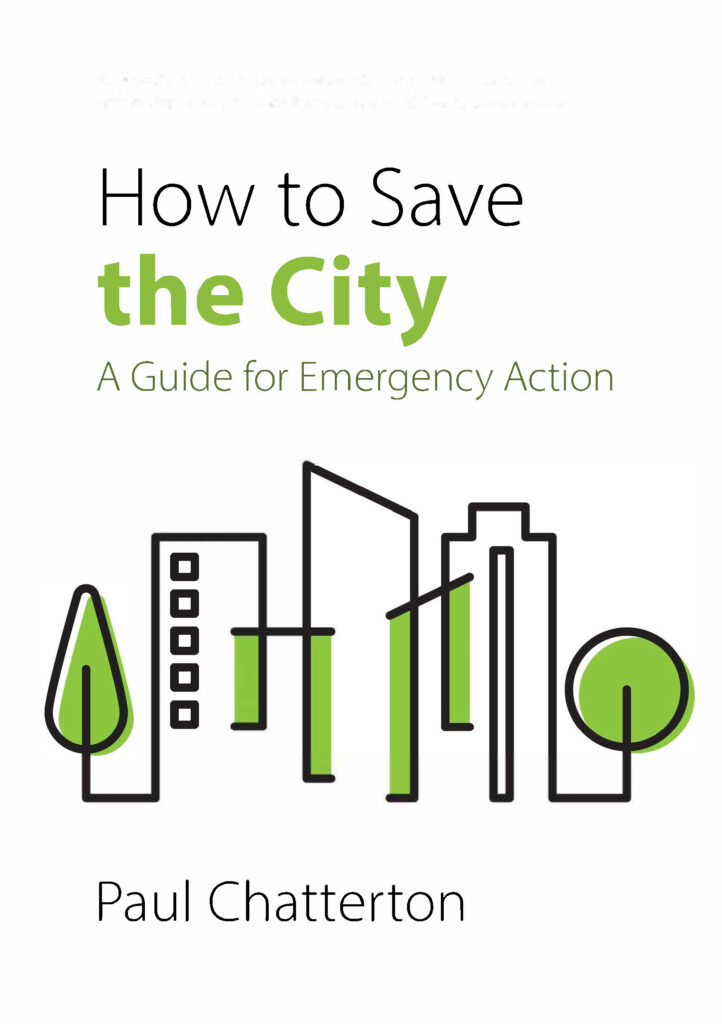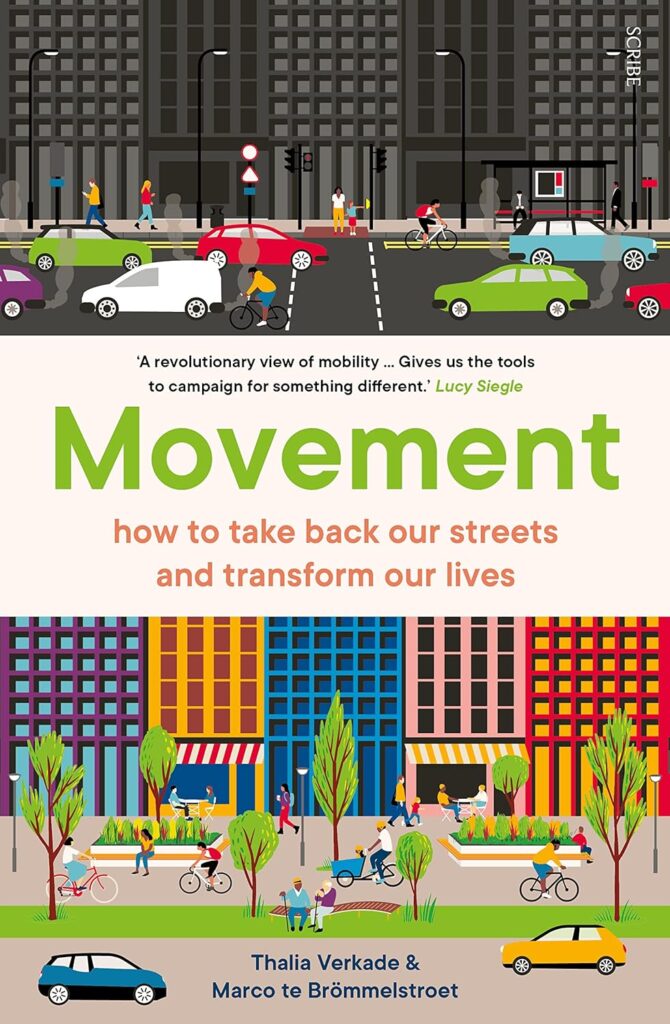“If there is one moment I really started to understand what is special about the Netherlands was when I was invited by a journalist to observe peak rush-hour traffic in Amsterdam. It allowed me to stand outside of my behavior and see the dynamic occurring at intersections. That’s when I realized how special cycling here is, and how it can provide a lens to rethink the language used in transportation planning.”
– Marco te Brömmelstroet
(p. 98)

What is it about?
In different parts of the world, there are extensive ideas and efforts to transform cities into more sustainable, liveable, healthy, and inclusive. Mobility and the way people move around in cities are directly linked to the realization of such goals. Dutch cities are considered beacons for sustainable urban planning, with a focus on cycling infrastructure and alternative transportation options.
But how can we learn from the Dutch? If we don’t just see them as “unattainable utopias” and don’t simply want to copy and paste, what is the right approach? Can the country that has spent decades building cycling infrastructure provide a blueprint for other cities? Or do we need to re-understand the Dutch cycling narrative? Or perhaps both?
Building the Cycling City, written by Melissa and Chris Bruntlett, is the story of an exploratory journey through Dutch cities to understand their cycling culture, policy and design. In search of a holistic view of the ups and downs of urban transformation in the Netherlands, a family from North America embarks on a journey through the world’s most bicycle-friendly cities to gain an interdisciplinary, historical and hands-on understanding of Dutch cycling practice and learn from them.
The Dutch cycling utopia wasn’t built in a day. It took over 50 years of incredibly hard work, a bit of good fortune, and some forward-thinking decisions that extended far beyond the current political cycle. Only because of all these factors do residents of the Netherlands enjoy a society that runs on the power of the bicycle, and the countless benefits that such a society brings to everyone, whether they choose to ride or not. By building superior places to cycle, the Dutch have also built superior places to live. And the entire world has a great deal to learn from their story.
(p. 6)
Chapter 1, Streets Aren’t Set in Stone, discusses the impact of the Second World War on Rotterdam’s urban development and the current measures and plans to create more space for cyclists and pedestrians. After the bombing, which some people saw as a “gift from God”, the city was rebuilt with an emphasis on modernism and functionalism, with wide roads and green spaces based on car-oriented planning. But the case of Rotterdam shows how a city can reclaim itself.
Chapter 2, No Sport, Transport, is about the bicycle itself, Dutch-style bicycles, bike shops, and e-bikes. The Dutch bicycle differs from other bicycles in its design, but its practicality and versatility make it a popular means of transportation in the Netherlands. The bike’s ergonomic design and comfortable seating position allow the rider to move effortlessly through the city streets and engage with the people and places around.
In Chapter 3, Fortune Favors the Brave, the authors report on the remarkable transformation of Groningen through the “Traffic Circulation Plan”. The temporary measures implemented as part of this plan eventually led to long-term changes that reshaped the cityscape. Van den Berg’s bold political leadership was crucial to this process and showed that anyone can bring about significant change if they take action.
In Chapter 4, One Size Won’t Fit All, we explore how the Netherlands can communicate its successful cycling strategies to a wider audience. In doing so, we consider the unique characteristics of each city and the interplay between hardware (safe and reliable cycling infrastructure) and software (behavior change and community mindset). By understanding these nuances, we can facilitate knowledge sharing between different contexts and create a global cycling revolution. The Dutch Cycling Embassy and PeopleForBikes are such organizations working with this mission.
Chapter 5, Demand More, looks at the evolution of Amsterdam’s cycling culture and the impact of various campaigns in the 1970s on the way people get around the city. The chapter also discusses the views of the “Cycling Professor,” Marco te Brömmelstroet, on cycling in the Netherlands and the Urban Cycling Institute, as well as the link between mobility and the social and behavioral sciences. Finally, the chapter uses the Boston experience to examine how tactical urbanism can be used to create greater demand for cycling.
Chapter 6, Think Outside the Van, focuses on the world of cargo bikes, which are currently experiencing a renaissance, with a new interest in these versatile and practical vehicles. The annual International Festival of the Cargo Bike in the Netherlands showcases the latest innovations and designs from companies such as Urban Arrow and B-Line in Portland. With their ability to carry heavy loads and navigate through tight spaces, they are an ideal solution for deliveries and other logistical needs in urban areas.
Chapter 7, Build at a Human Scale, delves into the unique story of Utrecht, another Dutch city with a rich history and rapid growth. It describes how spatial constraints have helped Utrecht maintain its human scale and seek alternatives to the car: pedestrians first, then bikes, then public transit, and finally, at the very bottom, the private automobile.
Chapter 8, Use Bikes to Feed Transit, explains the combination of bike and train in Dutch planning. An interconnected rail network throughout the country, huge bicycle parking facilities at stations, adaptability and scalability of the system ensure that bikes and trains reinforce each other in a reciprocal relationship.
Chapter 9, Put Your City on the Map, looks at the Hoverring (Eindhoven’s now world-famous suspended bike roundabout,) and Calgary’s Peace Bridge as two examples of iconic and attention-grabbing projects. It also explores Steven Fleming’s ideas about Velotopia, a future city built around cycling, and draws attention to cycling ‘outside the bubble’.
Chapter 10, Learn to Ride Like the Dutch, discusses the challenges that immigrant communities face in using bicycles as a mode of transportation and how organizations such as Mobycon are working to overcome these challenges. It points out that cycling is not just a matter of physical infrastructure, but also involves a set of social norms and values that have evolved. This is an important point as it highlights the need to consider the wider social and cultural context when designing cycling infrastructure and programs.
Reading “Building the Cycling City” is an captivating journey into the Dutch cycling culture, where a commitment to healthier living has led to a vibrant and thriving society. The country’s cycling infrastructure has been carefully crafted to prioritize human well-being, resulting in a more harmonious relationship between citizens and their surroundings.
The Dutch have learned to adapt to a rapidly changing world while maintaining their unique identity, and their success serves as a testament to the power of human ingenuity and collaboration. The true secret to their happiness lies not in technology, but in the simple joys of cycling and the beauty of a well-designed urban space.
What approach does it take?
The main approach of the book is based on interviews and real experiences of the authors. The entire book contains a kind of comparative comparison between Dutch and North American cities. The interviews with planners, policy makers, academics and advocates offer personal accounts with lessons learned from Dutch cycling cities and the stories of their own delightful first-hand experiences in Dutch cities have made the book a valuable resource for changing our approach to Dutch bike-friendly cities.
Who might be interested in this book?
The book is aimed at enthusiasts, policy makers, planners, activists and researchers who are interested in Dutch cycling cities and want to know how we can learn from them.
Further details
- Academic disciplines: mobilities, cycling studies, and urban planning.
- Geographical scope: Dutch and North American cities
- Relation to cycling: Dutch cycling is central to the book
- Reference (APA): Bruntlett, M., & Bruntlett, C. (2018). Building the cycling city: The Dutch Blueprint for Urban Vitality. Island Press.
Publisher website: Building the Cycling City: The Dutch Blueprint for Urban Vitality
To get to know the Dutch cycling cities better through a fascinating photo-essay book, take a look at Fietspad by Roy Symons



